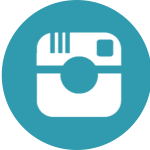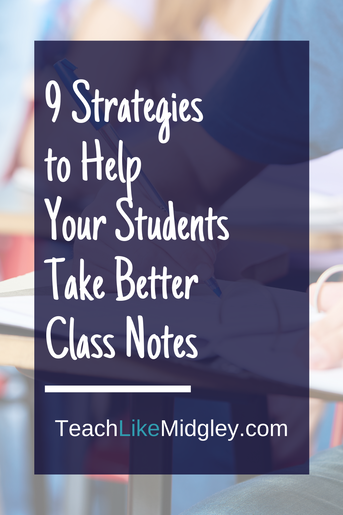9 Strategies to Help Your Students Take Better Class Note
Class notes can be tricky.
If you are a secondary teacher, then chances are pretty good that at some point you have asked your students to take notes.
If you are a secondary teacher, then chances are pretty good that at some point you have asked your students to take notes.
Maybe it was on a presentation you were giving, a reading passage, or even a video you were showing.
“Take out paper and pencil so you can take notes.”
As a student, that phrase would stress me out. Mostly because I had zero idea of what I was supposed to be taking notes on.
My mind would start racing with questions like:
How do I know what’s important?
What type of information am I supposed to write?
How much am I supposed to write?
How should I organize this information?
You get the idea. I would stress about taking notes so much I would miss half the point of the lesson.
As teachers, we tell our students to write down anything they think is important.
But that’s a very subjective direction. What’s important to us, may not be important to them. And vise versa.
And then ultimately, the lesson is over and student papers either have way too much crammed on the page or hardly anything at all.
I quickly discovered that note-taking was an important skill my 6th graders needed guidance in developing.
In order to do that, I had to start giving them structure for their note-taking.
Not only did they need structure for organizing their notes, but they also needed structure by way of a focus for what type of information to look for during the lesson.
When I started providing this for my students, I saw a massive improvement. Not only were the class notes more complete and accurate, but my students also gained a better understanding of the objective, because they knew where to focus their efforts.
In this post, I’m going to share with you 9 strategies to help provide your students with structure while taking class notes.
“Take out paper and pencil so you can take notes.”
As a student, that phrase would stress me out. Mostly because I had zero idea of what I was supposed to be taking notes on.
My mind would start racing with questions like:
How do I know what’s important?
What type of information am I supposed to write?
How much am I supposed to write?
How should I organize this information?
You get the idea. I would stress about taking notes so much I would miss half the point of the lesson.
As teachers, we tell our students to write down anything they think is important.
But that’s a very subjective direction. What’s important to us, may not be important to them. And vise versa.
And then ultimately, the lesson is over and student papers either have way too much crammed on the page or hardly anything at all.
I quickly discovered that note-taking was an important skill my 6th graders needed guidance in developing.
In order to do that, I had to start giving them structure for their note-taking.
Not only did they need structure for organizing their notes, but they also needed structure by way of a focus for what type of information to look for during the lesson.
When I started providing this for my students, I saw a massive improvement. Not only were the class notes more complete and accurate, but my students also gained a better understanding of the objective, because they knew where to focus their efforts.
In this post, I’m going to share with you 9 strategies to help provide your students with structure while taking class notes.
Class Notes Organization Strategies
#1 Titles, Dates, & Page Numbers
No matter what class, subject, or type of notes you have your students complete, be sure they use titles, dates, and page numbers.
Whether the notes are kept in a notebook or binder, students need to be able to find their notes quickly. They need to be able to look at a page and immediately know what type of information is written there.
If we don’t teach our students how to use the notes we’ve written down, then what exactly is the point of the exercise anyways?
#2 Headings
Dividing up the notes with headings or subheadings can be super helpful to students when trying to find specific information.
Be sure to teach them how to use size to make their headings stand out.
A simple rule of thumb, is to use the subsections of a textbook lesson or the titles on slides of PowerPoint presentations as the headings in class notes.
#3 Color Code
This strategy is especially helpful for your visual learners. Using colors to distinguish between different chunks of information can be especially helpful.
Marking all the key vocabulary in orange. Or all information related to location and geography green. Are just a few examples.
If color coding is not a viable option, then at least teach your students to underline, circle, or bold item to help them stand out.
#4 Doodle Images
Sometimes just writing down words is not enough. When giving examples, use small, simple doodles to help give explanations. Encourage your students to include them in their notes. Remember it’s not art class, it’s just a fun way to help students understand concepts.
No matter what class, subject, or type of notes you have your students complete, be sure they use titles, dates, and page numbers.
Whether the notes are kept in a notebook or binder, students need to be able to find their notes quickly. They need to be able to look at a page and immediately know what type of information is written there.
If we don’t teach our students how to use the notes we’ve written down, then what exactly is the point of the exercise anyways?
#2 Headings
Dividing up the notes with headings or subheadings can be super helpful to students when trying to find specific information.
Be sure to teach them how to use size to make their headings stand out.
A simple rule of thumb, is to use the subsections of a textbook lesson or the titles on slides of PowerPoint presentations as the headings in class notes.
#3 Color Code
This strategy is especially helpful for your visual learners. Using colors to distinguish between different chunks of information can be especially helpful.
Marking all the key vocabulary in orange. Or all information related to location and geography green. Are just a few examples.
If color coding is not a viable option, then at least teach your students to underline, circle, or bold item to help them stand out.
#4 Doodle Images
Sometimes just writing down words is not enough. When giving examples, use small, simple doodles to help give explanations. Encourage your students to include them in their notes. Remember it’s not art class, it’s just a fun way to help students understand concepts.
Class Notes And Providing Structure
#5 Graphic Organizers
A plain old piece of paper can get boring. Especially for students. Mix things up and use graphic organizer to organize the information.
Some textbooks even provide organizers that are designed to go with their lessons.
You can also look at your lesson, determine how many subsections there are, and use an organizer that has that many sections. Quick, easy, organization.
#6 Foldable Activities
Either you love them, or you don’t. But either way, you can’t deny that a folding activity can break up the monotony of note taking.
They are also a great way to help organize. They don’t have to be fancy. Even the simplest styles can have a big impact.
#7 Structure Strips
One of my favorite tools for students and notebooks. A simple strip of paper glued on the left hand side of the page. The blocks give guidance for how much information to write.
In the blocks, you can put the subsection titles, review questions, or even key words.
These are great for when you need something different without a lot of prep work. You can easily print 4 strips on one page, make some copies, and chop them up with your paper cutter. Distribute and a quick glue in, and you’re ready to roll.
A plain old piece of paper can get boring. Especially for students. Mix things up and use graphic organizer to organize the information.
Some textbooks even provide organizers that are designed to go with their lessons.
You can also look at your lesson, determine how many subsections there are, and use an organizer that has that many sections. Quick, easy, organization.
#6 Foldable Activities
Either you love them, or you don’t. But either way, you can’t deny that a folding activity can break up the monotony of note taking.
They are also a great way to help organize. They don’t have to be fancy. Even the simplest styles can have a big impact.
#7 Structure Strips
One of my favorite tools for students and notebooks. A simple strip of paper glued on the left hand side of the page. The blocks give guidance for how much information to write.
In the blocks, you can put the subsection titles, review questions, or even key words.
These are great for when you need something different without a lot of prep work. You can easily print 4 strips on one page, make some copies, and chop them up with your paper cutter. Distribute and a quick glue in, and you’re ready to roll.
#8 Cornell Notes
This is 100% my favorite note-taking structure to provide for students.
By teaching this strategy, you will be setting them up for success in their future academic endeavors.
Many secondary teachers don’t provide note-taking structures (which is why I’m writing this post!), and by teaching your students how to do it for themselves, they can find success.
While I start the year by providing a copy of the structure for students to glue into their notebook, by the end of the school year, students know how to draw the basic framework for themselves and have confidence to fill it out.
Writing a summary of what you’ve learned at the end of a lesson is also one of the best techniques you can teach your students with their learning as well.
#9 Organize Your Curriculum
This strategy does not just apply to note-taking, but your teaching in general.
Most often when a student does not like a subject or claims it’s too hard, it’s not because of the content. It’s more likely that they just don’t know how to approach learning that content.
By giving students a structure, you are helping them to identify what is important and what they need to focus on. It relieves an enormous amount of stress for yours students.
This especially holds true in history and science classes, where new content can be very overwhelming and confusing.
When I teach ancient history, I use a 7 part structure. Students learn the 7 key components to any civilization. This becomes our focus for every lesson.
What’s important from a textbook lesson. What’s important from a video. What’s important from a reading passage. What’s important from a presentation. It all revolves around the 7 part structure. Sometimes we are focused on one particular part, other times students identify pieces and label which part it connects with.
This method does not dumb down material, as some may think. Rather, it simply organizes the material to help make it easier for students to focus and understand.
This strategy is especially helpful for students in middle school. You as the teacher are modeling for them how to organize information. When they reach high school and college, they will have developed excellent learning skills that will help them organize and study – because you modeled for them how to do it.
This strategy does not just apply to note-taking, but your teaching in general.
Most often when a student does not like a subject or claims it’s too hard, it’s not because of the content. It’s more likely that they just don’t know how to approach learning that content.
By giving students a structure, you are helping them to identify what is important and what they need to focus on. It relieves an enormous amount of stress for yours students.
This especially holds true in history and science classes, where new content can be very overwhelming and confusing.
When I teach ancient history, I use a 7 part structure. Students learn the 7 key components to any civilization. This becomes our focus for every lesson.
What’s important from a textbook lesson. What’s important from a video. What’s important from a reading passage. What’s important from a presentation. It all revolves around the 7 part structure. Sometimes we are focused on one particular part, other times students identify pieces and label which part it connects with.
This method does not dumb down material, as some may think. Rather, it simply organizes the material to help make it easier for students to focus and understand.
This strategy is especially helpful for students in middle school. You as the teacher are modeling for them how to organize information. When they reach high school and college, they will have developed excellent learning skills that will help them organize and study – because you modeled for them how to do it.
Final Thoughts About
Students and Class Notes
You can provide organization and structure to your students for note-taking, no matter what your teaching style or preferences may be. At the very least, when you ask students to take notes, ask them to focus on the 5 W's - Who, What, When, Where, Why - as a very simple structure. This is always a good default, no matter what the class or subject. You will be surprised at just how much it helps!
If you want to know more about the strategies I've mentioned here, then check out these posts:
If you want to know more about the strategies I've mentioned here, then check out these posts:
Let's Connect...

Welcome! I'm Hillary Midgley, a veteran 6th grade teacher.
I create educational materials and develop curriculum for other teachers. I specialize in teaching students how to learn through my Study Skills Curriculum. I have established fundamental classroom systems and structures for teachers to help them streamline their classroom. And my passion is teaching ancient history through engaging activities with foundations in academic skills. Here you will find resources on all of these topics and more. Learn more about me here.
|










